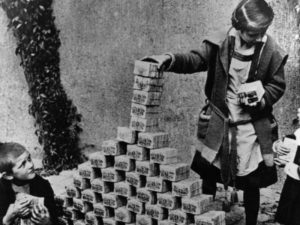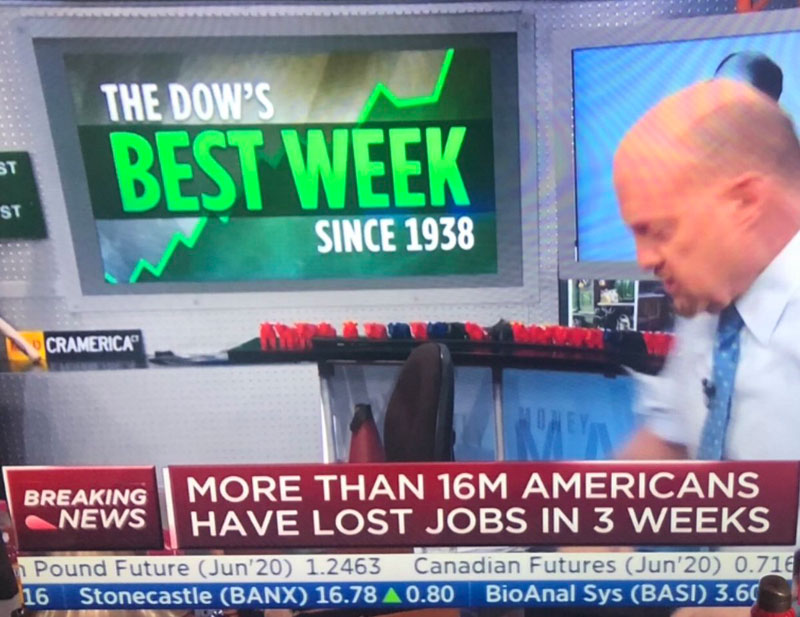There are 2 crises happening concurrently now — one is coronavirus crisis, and two is economic crisis. Much of the media attention is focused on the former but the global economic crisis is fast unfolding. As a large part of the world closed its borders and entered into shut-down mode, I believe that the economic and market impact of the COVID-19 coronavirus will be much greater than what most people think.
I wrote on LinkedIn 3 weeks ago on 19th March 2020: “I now believe there is > 80% probability that: Central banks will print, print, print to inject liquidity, buy bonds and stocks in attempts to halt the free-fall. Governments will be sending cheques to everyone…”. Since then, U.S. has unveiled a $2T fiscal stimulus plan, Germany €750B, Japan $990B, Malaysia MYR260B, and Singapore S$60B among many others. I’m not saying that governments shouldn’t be printing money now to provide lifeline to millions of people who have lost their jobs and facing problem of feeding their families. What is important is to understand how did the world end up with today’s situation and learn the necessary lessons so that we can hopefully support the reset of the system in a way that will ensure a fairer, better, and sustainable future for all moving forward, including future generations.
 Milton Friedman floated the “helicopter money” idea back in 1969, half-jokingly. Keynesian economists, most notably ex-Fed chairman Ben Bernanke, took the idea seriously.
Milton Friedman floated the “helicopter money” idea back in 1969, half-jokingly. Keynesian economists, most notably ex-Fed chairman Ben Bernanke, took the idea seriously.
Ben Bernanke launched Quantitative Easing QE1,2,3 after 2008 financial crisis and even author a self-congratulatory book “The Courage to Act”. Institute of International Finance estimated that total global debt had reached $253 trillions by end-September 2019. Just 1% increase in interest rate would meant several trillions more in interests to pay. Which partly explains why interest rates have been kept so low post 2008. QE coupled with low interest rates spurred reckless borrowing and fuelled several assets bubbles. Corporates take on cheap debts to fund stock buybacks, driving up their share prices, and CEOs meet their KPI and pay themselves huge bonuses. The bull market from March 2009 till February 2020 is the longest in history. The cheap debts also find its way into private equity funds and enabled even startups with unprofitable business models, such as Ofo and WeWork, to become unicorns. All these bubbles are there before the coronavirus crisis hit. The coronavirus virus is merely the pin that burst the bubbles.
None of lessons from 2008 was learned. No CEO of banks or financial institutions, that gave out loans recklessly, created all kinds of fraudulent financial products and profited handsomely, went to jail. Instead these financial institutions that were on the brink of collapse were bailed out. The rampant greed and recklessness in the financial sector that caused the 2008 subprime mortgage situation, has now spread widely across various sectors, and the world risk facing a financial crisis 10 times worse than 2008.
Something created out of nothing, has intrinsic value of nothing. Fiat currency is not backed by a physical commodity, such as gold or silver, but rather by the government that issued it. It is interesting to observe that so many people don’t trust their own government but somehow trust the currency their government issued. U.S. national debt is $23 trillion. A debt that U.S. government will not be able to pay back ever.
Why is it then that countries still trust the US dollar? To answer this question, we need to go back to 1944. Preparing to rebuild the international economic system while World War II was still raging, delegates from all 44 Allied nations gathered in Bretton Woods, New Hampshire, United States. The Bretton Woods system were an obligation for each country to adopt a monetary policy that maintained its external exchange rates within 1 percent by tying its currency to gold and the ability of the IMF to bridge temporary imbalances of payments. The United States, which controlled two thirds of the world’s gold then, insisted that the Bretton Woods system rest on both gold and the US dollar. Throughout the 1950s Washington sustained a balance of payments deficit to finance loans, aid, and troops for allied regimes. But during the 1960s the costs of doing so became less tolerable. By 1970, the U.S.. had seen its gold coverage deteriorate from 55% to 22%. On 15 August 1971, the United States unilaterally terminated convertibility of the US dollar to gold, effectively bringing the Bretton Woods system to an end and rendering the US dollar a fiat currency.
After the collapse of the Bretton Woods gold standard, U.S. struck a deal with Saudi Arabia to standardize oil prices in US dollar terms. Through this deal, the petrodollar system was born, along with a shift away from pegged exchanged rates and gold-backed currencies to non-backed, floating rate regimes. The petrodollar system elevated the U.S.. dollar to the world’s reserve currency and, through this status, the United States is able enjoys persistent trade deficits and is dominate the global economy.
Basically abusing its special reserve currency status, various terms of U.S. governments and Fed have continued to increased U.S. national debts, with its artificial “debt ceiling” raised several times over the past 40+ years. Time published an article “25 People to Blame for the Financial Crisis — The good intentions, bad managers and greed behind the meltdown”. Fed ex-chairman Alan Greenspan kept interest rates too low for too long, encouraging a bubble in house prices to grow between 2002 and 2006. Chris Cox, the ex-SEC chief, was blind to allegations of trading fraud and was lax in enforcement to limit the massive leveraging by big investment banks like Lehman Brothers and Merrill Lynch. Henry Paulson was CEO of Goldman Sachs before he became Treasury Secretary in 2006. Paulson pushed through Congress legislation to authorise the buying of the toxic assets from the banks to take the risk off their books and increase their cash reserves, basically rescuing his buddies. Paulson and Bernanke lobbied Congress, with Bernanke emphasising the potential of fallout worse than the Great Depression if they fail to act. Fed bailout several “too big too fail” investment banks and corporations. The supposedly temporary emergency measures became pretty much permanent through subsequent launch of various monetary and fiscal interventions, including the QEs, to keep the system alive.
Wall Street and corporate America, knowing they have their buddies in the Fed and government, became even more reckless. Post-2008, it was not just U.S. that printed lots of money. China, ECB, Japan central banks they all went into massive printing and created much more credit. This has led to bubbles forming in almost all assets: real estate, stocks, private equities, bonds, etc. Even students loans in U.S. snowballed to $1.5 trillion in federal student loan debt.
Despite bull runs in many stock markets worldwide from 2009, the economy didn’t really recover in many countries. Real estate bubble led to increasingly high rental cost for many small-medium sized businesses, squeezing their margins thin. Although the unemployment rates seem low in many countries, the under-employment and “not in the labor force” numbers grew significantly. Long-term unemployment, people who has not had a job for more than 6 months and given up looking, grew significantly but that number is conveniently hidden in the “not in the labor force” statistics. U.S. labor force statistics indicated that 97.2 millions persons not in the labor force as of March 2020. Note that U.S. population 16 years and above was 259.2 millions, so seen in another way, the “not in labor force” percentage is a huge 37.5%. Reckon there are so many happy American retirees, adult students and homemakers, who prefer not to work?
Meanwhile, U.S. stock indexes keep breaking new records. The market boom, which started March 2009, had enjoyed a whopping 460+% gain for the S&P 500, the longest bull-run in history. U.S. CEO-to-worker pay ratio hit 278-to-1 in 2018, up from just 20-to-1 in 1965. The income gap, the rich-poor divide widen.

To address the growing unemployment and under-employment, some governments have experimented with Universal Basic Income, to provide enough to cover the basic cost of living and provide financial security. Some economists even advocated Modern Monetary Theory (MMT) that proposes governments that control their own currency can spend freely, as they can always create more money to pay off debts in their own currency. The theory suggests government can simply print infinite money to spend on growing the economy to its full capacity, enrich the private sector, eliminate unemployment, and finance major programs such as universal healthcare, free college tuition, and green energy. Sounds really good, does it works in practice? Look at Weimar Republic (Germany) and Zimbabwe for some clues.
In September 2019, things started to be a bit shaky. The U.S. repurchase, or repo market is which banks and companies temporarily trading bonds for cash and then redeeming them, usually overnight, it is who keeps financial markets liquid. Cash available to banks for their short-term funding needs, all but dried up in mid-September 2019, and interest rates in U.S. money markets shot up to as high as 10% for some overnight loans, more than four times the Fed’s rate.
Historical low interest rates over so many years, massive printing of currencies by various central banks provided access to cheap money for investors have fuelled bubbles in almost all assets. Then came the coronavirus pin that burst the bubbles. First to go was the stock market bubble, by mid-March 2020, the U.S. equities market has lost $11.5 trillionin capitalisation. Within 3 weeks, 16 millions Americans lost their jobs. With a large part of the world entering into lockdowns, the global economy goes into hibernation. Many small-medium businesses will or already have run into cash flow crisis, they will likely go bankrupt and millions of jobs lost worldwide. Unfortunately, unlike the reckless large corporations and banks which are one of the causes of this unfolding economic crisis, these small-medium enterprises (SMEs) will not be deem “too big to fail” and not likely to be bailout.
There was a brief re-bounce in the U.S stock market in the week of 6 April, and this screenshot by a Twitter user on 10 April highlight “Everything that is wrong with America, in one image.”

Instead of learning important lessons from 2008, the past 11 years U.S. and much of the developed economies had doubled down on recklessness. Take for example Germany’s Deutsche Bank, it was allowed to created over the years a whopping $53.5 trillion (€48 trillion) book of derivatives contracts.
It has taken me much more time than I had expected, when I started, to write this summary of my learnings from past 11 years since 2008. I’ve yet to get into the main part of sharing on what could SMEs and individuals do. Nevertheless, it is important to understand how we get to today’s situation in order for you to form your own plans of what to do next.
In Part 2, I plan to cover more on the economic crisis that is unfolding, on the impact digital technologies, and on what forward thinking individuals like Ray Dalio had shared. I will share some thoughts on the new normal we might see, the importance of productivity and innovations to build a more sustainable global economy and what small-medium sized businesses and individuals can do to prepare and adapt to the post-coronavirus crisis new global business/job environment.
Khengwah Koh
This blog was first published on Medium on 14 April 2020 .
Khengwah Koh is the Founder and Principal Consultant of Askvisor, a boutique management consulting firm that supports clients in digital transformation, design thinking, new products/services/business models innovation, digital branding and marketing.

